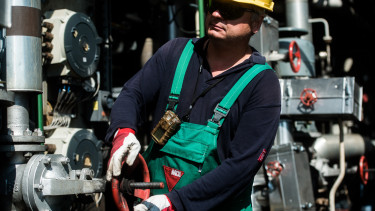COVID-19: 733 people in hospital, 17 deaths over the past 24 hours in Hungary

The number of new confirmed daily COVID-19 cases is lower than a year ago but the key metric in the current 'wave' is the number of patients in hospital on ventilator, which figures, especially the ratio of ventilated patients to those hospitalised, are far less reassuring.

The current 'wave' was more deadly in August and in the better part of September, but in terms of Covid deaths accumulated since 1 August (to 11 October), we are slightly better off now than a year ago.

And here's the 'balance' of new cases, their accumulation, and Covid fatalities and their accumulation for October (1-11) alone, compared with the same period of 2020.

Number of patients in hospital, days spent in hospital
The left-hand chart depicts the accumulated number of confirmed daily COVID-19 cases and days spent in hospital by coronavirus patients. The accumulated number of new cases in the period under review is about half what we had a year ago. Up until 22 September, those admitted in hospital stayed there longer than in the base period, but then the trend changed.
The number of accumulated cases (between 28 August and 11 October) is about 45% (18,000) of what we had last year (cc. 33,300), yet the number of days spent in hospital is not much lower (-20%).
The conclusion is that only those infected people are detected and included in the statistics that seek help due to their severe symptoms.
On the right-hand chart you find that the both curves (accumulated number of new cases) keep more or less parallel with the columns, only the 'wrong' columns. The columns show the accumulated number of days COVID-19 patients spent on ventilator (much more this year) but what the relation between the curves and the columns tell us is that there should be way more cases and a lot more hospitalised patients for this kind of overall severity of cases.

Ratio of COVID-19 patients on ventilator to those in hospital
As regards the two charts below, the percentage of ventilated COVID-19 patients relative to the number of patients hospitalised (7-day averages) has been rising in the period under review in 2021, it was dropping in the base period. The gap, however, which could only be described as dramatic, has been closing as the curve started to flatten this year and the ratio began to worsen a year ago.
Previously, the gap was widening most likely because last year even those with mild coronavirus symptoms were admitted to hospital, while these days only those are hospitalised that are in severe/critical condition, hence the higher number (and ratio) of them ending up on ventilator.

Patients in hospital, on ventilator, days spent in hospital and on ventilator
The left-hand chart depicts the number of coronavirus patients in hospital and on ventilator (3-day averages) between 18 July and 11 October, both in 2020 and 2021. The right-hand chart shows the accumulated number of days spent in hospital and on ventilator by COVID-19 patients, also between 18 July and 11 October in 2020 and 2021.
On the left-hand chart we can see that the number of COVID-19 patients in hospital was largely the same in 2020 and this year up until mid-September. Thanks to vaccination coverage the number this year should not have been even half of what we had last year, especially if cross-immunity gained earlier (in the previous waves or epidemics) work.
The numbers (green columns and green area with yellow curve) basically overlapped until mid-September, and they were the closest (644 vs. 595) six days ago. Since then the gap has been wiening and reached 565 by Monday: 1,281 COVID-19 patients in hospital on 11 October 2020 compared with 717 this year (3-day averages). That was the 'good news'. The not so good news is that the 3-day average of Covid patients on ventilator is not that different than a year ago (109 vs. 134 last year). However, we must note that this marks an improvement as in the period under review, the base period's figure was higher for the first time on Sunday (110 vs. 107) and the difference has just got bigger.
On the right-hand chart, the ratio of days spent in hospital to the accumulated number of COVID-19 cases is 96.5% (pinkish columns), while it was less than 65% last year (green area). The conclusion is the same. About 50% more coronavirus patients should be in hospital to match this ratio, and there are still a lot more than what the number of cases would warrant. If the detection rate of coronavirus infections was considered low in 2020, it’s cannot even be registered this year.
The number of days spent on ventilator relative to the accumulated number of new cases was around 4.7% last year (green curve), while it is 13.3% this year (red curve). What’s the deal here?
What we see is the piling up of various factors: (i) underdetection, (ii) fewer people in hospital than there should be, (iii) patients hospitalised in more serious condition.

The four charts below show the absolute number of COVID-19 patients in hospitals and on ventilators (top two) as well as two ratios (COVID-19 cases in hospital / Active cases, and COVID-19 cases on ventilator / Cases in hospital, bottom two.) The left-hand charts depict a longer period (15 June - 11 Oct), while the right-hand ones show changes over a shorter period (25 July - 11 Oct). The ascending trend is clear as regards the number of people in hospital and on ventilator. As for the ratio of those on ventilator to those hospitalised, the 3-day averages show stagnation around 15% for the past week or so.


Accumulated number of COVID-19 cases and fatalities, days spent in hospital and on ventilator
On the left-hand chart, the green curve shows the accumulation of new cases in 2020 (in the period under review) which correlates more with the black columns, i.e. the accumulated number of COVID-19 deaths in 2021. Why is that? The number of detected cases is half this year than in the base period; see the green and the yellow curves. (Additionally, the test positivity rate is also half, but that’s another story).
This wave / epidemic was deadlier than it was in the same period a year ago until mid-September, but, as the columns attest, the situation has improved in this respect since then. Not that this many Covid fatalities were acceptable, only the second wave was more devastating in this particular comparison.
On the right-hand chart you see that the accumulated number of days coronavirus patients spent in hospital this year was higher than in 2020 in the period under review up until 22 September (red columns are higher than the light blue columns), while the number of days spent in ICUs is about 55% higher than the 2020 data.

Vaccination concerns
Given that vaccinations have practically stalled at a vaccination coverage of about 60%, and the cabinet has no intention to tighten anti-pandemic measures, we see no reason why the epidemiological situation should improve in the immediate future. There is a much greater chance that the numbers will keep worsening for a while.



According to the results of antibody level tests performed by Videoton, the situation is not reassuring in respect of China's Sinopharm vaccine, either.
The latest round of voluntary testing in progress among the company's 8,600 employees since July (with more than 800 of them tested) showed that a lot of people in the 60+ age group that have received Sinopharm jabs had an extremely low level of or absolutely no anti-SARS-CoV-2 antibodies. About 27% of this age group have received Sinopharm AND some 550,000 of them have not been inoculated against coronavirus at all.

Most reassuringly, a third dose (of Pfizer/BioNTech's Comirnaty) gave a solid boost to their antibody levels.
The average antibody count in this group of 60+ people was 141 AU/mL, and a lot of the subjects did not have even the critical 50 AU/mL. Following the third dose, which was the Pfizer/BioNTech vaccine (Comirnaty) in every case, the average antibody level shot up to 18,000.
Cover photo: Getty Images











